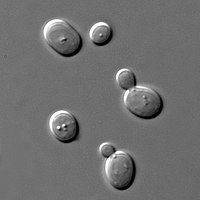
SILAC Expands its Territory to the Pathogenic Yeast, Candida albicans
Sign Up to like & getrecommendations! Published in 2018 at "PROTEOMICS"
DOI: 10.1002/pmic.201700458
Abstract: Quantitative proteomic analysis using stable isotope labeling with amino acids in cell culture (SILAC), as metabolic labeling with MS, has been used as an excellent technique to measure relative abundance change in proteins and post‐transitional… read more here.
Keywords: pathogenic yeast; candida albicans; silac expands; expands territory ... See more keywords

Utilization of size polymorphism in ITS1 and ITS2 regions for identification of pathogenic yeast species.
Sign Up to like & getrecommendations! Published in 2017 at "Journal of medical microbiology"
DOI: 10.1099/jmm.0.000426
Abstract: Despite the existence of a variety of available yeast identification strategies, easier and more cost-effective methods are required for routine use in clinical laboratories. The internal transcribed spacer (ITS) regions of fungal rRNA genes exhibit… read more here.
Keywords: pathogenic yeast; candida; its2 regions; yeast ... See more keywords

Environmental reservoirs of the drug-resistant pathogenic yeast Candida auris
Sign Up to like & getrecommendations! Published in 2023 at "PLOS Pathogens"
DOI: 10.1371/journal.ppat.1011268
Abstract: Candia auris is an emerging human pathogenic yeast; yet, despite phenotypic attributes and genomic evidence suggesting that it probably emerged from a natural reservoir, we know nothing about the environmental phase of its life cycle… read more here.
Keywords: resistant pathogenic; environmental reservoirs; pathogenic yeast; yeast ... See more keywords

Interaction of Host Proteins with Cell Surface Molecules of the Pathogenic Yeast Trichosporon asahii.
Sign Up to like & getrecommendations! Published in 2023 at "Medical mycology journal"
DOI: 10.3314/mmj.22-00020
Abstract: Trichosporon asahii is an invasive pathogenic yeast that infects immunocompromised hosts. Several virulence factors contribute to the fungal infection; however, the factors that contribute to the occurrence of T. asahii infections remain unclear. Since adhesins… read more here.
Keywords: interaction; cell surface; asahii; trichosporon asahii ... See more keywords

N-acetylglucosamine Signaling: Transcriptional Dynamics of a Novel Sugar Sensing Cascade in a Model Pathogenic Yeast, Candida albicans
Sign Up to like & getrecommendations! Published in 2021 at "Journal of Fungi"
DOI: 10.3390/jof7010065
Abstract: The amino sugar, N-acetylglucosamine (GlcNAc), has emerged as an attractive messenger of signaling in the pathogenic yeast Candida albicans, given its multifaceted role in cellular processes, including GlcNAc scavenging, import and metabolism, morphogenesis (yeast to… read more here.
Keywords: glcnac; pathogenic yeast; candida albicans; yeast ... See more keywords

Insight into the Antifungal Effects of Propolis and Carnosic Acid—Extension to the Pathogenic Yeast Candida glabrata: New Propolis Fractionation and Potential Synergistic Applications
Sign Up to like & getrecommendations! Published in 2023 at "Journal of Fungi"
DOI: 10.3390/jof9040442
Abstract: Fungi have traditionally been considered opportunistic pathogens in primary infections caused by virulent bacteria, protozoan, or viruses. Consequently, antimycotic chemotherapy is clearly less developed in comparison to its bacterial counterpart. Currently, the three main families… read more here.
Keywords: pathogenic yeast; yeast candida; carnosic acid; candida glabrata ... See more keywords

Combination of Six Individual Derivatives of the Pom-1 Antibiofilm Peptide Doubles Their Efficacy against Invasive and Multi-Resistant Clinical Isolates of the Pathogenic Yeast Candida albicans
Sign Up to like & getrecommendations! Published in 2022 at "Pharmaceutics"
DOI: 10.3390/pharmaceutics14071332
Abstract: In previous studies, derivatives of the peptide Pom-1, which was originally extracted from the freshwater mollusk Pomacea poeyana, showed an exceptional ability to specifically inhibit biofilm formation of the laboratory strain ATCC 90028 as a… read more here.
Keywords: derivatives pom; yeast candida; pathogenic yeast; multi resistant ... See more keywords